
Feature Article
Guardians of the Plate: The Vital Role of Food Surveillance Programme
It is everyone’s duty to maintain food safety. Both consumers and the food businesses should include the Five Keys to Food Safety in their daily routines to prevent foodborne diseases. The Codex Alimentarius Commission (Codex) provides detailed principles and guidelines for food control systems. Codex pointed out that an effective food control system is essential for ensuring the safety and suitability of food for consumers and ensuring fair practices. Additionally, food surveillance is a crucial component of an extensive food control system that enhances food safety and public health. This system includes upstream measures such as import protocols for high-risk foods, regulations and standards, and downstream activities like food surveillance, all working in collaboration.
As advocated by Codex, one key principle of an effective food control system is the adoption of a whole food chain approach to food surveillance, ensuring that monitoring occurs at various stages — from farm to table — to proactively detect and mitigate risks before products reach consumers. Practices in food surveillance vary widely across different regions, reflecting each area’s unique challenges, regulatory environments, adherence to international standards and levels of development.
Food Surveillance in Hong Kong
Food surveillance involves the continuous monitoring and assessment of the food supply chain to detect and address risks associated with food safety. This proactive approach helps in identifying potential hazards before they cause harm, ensuring that corrective actions can be implemented swiftly. Surveillance data are crucial for risk assessment and management, guiding policy decisions and prioritising regulatory focus.
In Hong Kong, the Food Surveillance Programme (FSP) conducts safety tests on about 65 000 food samples each year, which translates to about 9 samples per 1 000 people, a sampling rate that is relatively higher compared to other jurisdictions. To protect public health, it is essential to maintain vigilant oversight and take immediate risk management steps in response to any unfavourable outcomes from the FSP.
Main Features of the Centre for Food Safety (CFS) Food Surveillance Programme
Throughout the year, the CFS collects food samples at various levels including import, wholesale, and retail/catering. Dedicated food control offices at the border ensure timely collection of samples from foods imported via different routes. Additionally, samples are systematically gathered from wholesale markets, retail outlets, food factories and restaurants. With the rise of online shopping, a portion of retail samples are now procured through online platforms, reflecting the changing consumer behaviour towards internet shopping.
The CFS’s FSP monitors a broad spectrum of foods and potential risks, incorporating seasonal variations. It includes routine, targeted, and seasonal surveillance projects. Routine surveillance covers major food groups like vegetables, fruits, poultry, aquatic products, dairy products and eggs, ensuring their compliance with food safety standards. Targeted surveillance addresses specific risks such as illegal addition of sulphur dioxide in fresh meat or the presence of Cronobacter sakazakii in infant milk powder. Seasonal surveillance aligns with cultural festivals or seasonal consumption patterns, such as examining rice dumplings during the Tuen Ng Festival period or mooncakes during the Mid-Autumn Festival period to ensure food safety during peak consumption periods.
Risk-based Sampling and Test Selection
1A risk-based approach is adopted for the selection of food samples and testing parameters, prioritising high-risk foods, previous unsatisfactory samples, reports of local or overseas food incidents, intelligence and public concerns. An internal review is conducted regularly to reflect new legislation and standards. The testing scope includes chemical, microbiological and radiological hazards, ranging from food additives and contaminants to pathogens and radiological parameters, as well as antimicrobial resistance bacteria (Figure 1).
The FSP is reviewed by the Expert Committee on Food Safety before implementation. Additionally, a working group focuses on the unique challenges arising from food purchased via online platforms, adapting surveillance methods to this modern shopping trend. The outcomes of these surveillance activities and the progress of the working group are reported regularly to the Panel on Food Safety and Environmental Hygiene of the Legislative Council, contributing to transparency and continuous improvements in food safety practices.
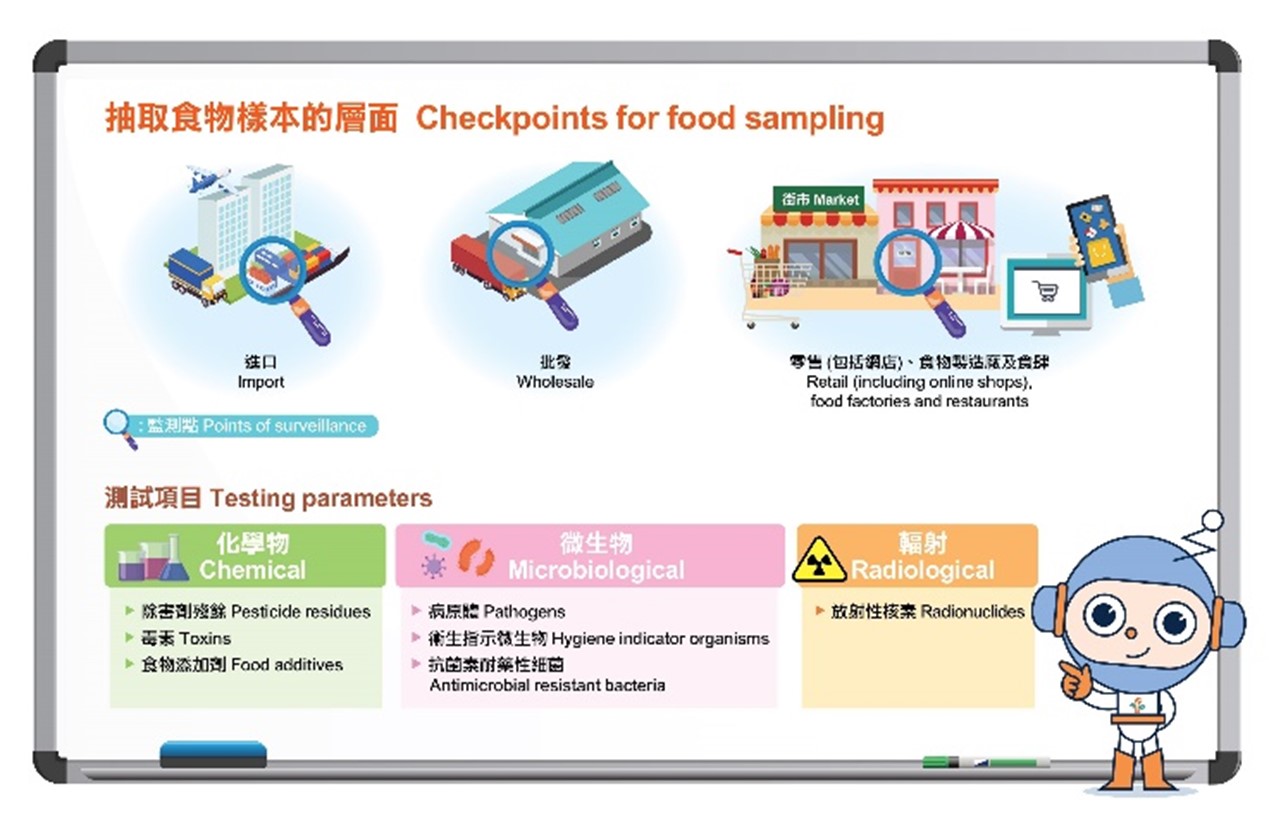
Figure 1: The Food Surveillance Programme of the CFS monitors the safety of different types of food at different levels
How does the FSP Safeguard Food Safety
The FSP is an important component of the food safety framework, engaging in risk-based monitoring to ensure food safety and compliance with standards. It not only systematically collects a wide array of food samples for analysis of contaminants like pathogens, chemical residues and toxins, but also enforces regulatory compliance and prosecutes non-compliant entities. Enforcement is crucial for keeping pace with new regulations. Furthermore, the FSP supports risk management and communication strategies, ensuring the public is kept informed of essential food safety information through clear reporting and dissemination. This is achieved via press releases, social media and other platforms when samples do not meet safety standards. Other risk management measures, including source tracing, product recalls, notification to the place of origin and import suspension, are also implemented. Food Safety Reports are released regularly to keep the public informed.
In summary, the CFS upholds food safety through rigorous surveillance, ensuring compliance, and acting promptly to address any issues related to unsatisfactory results. This proactive and comprehensive approach is vital for preventing foodborne diseases and protecting public health.
Mascot ON in Lesson
1. Beware of Grayanotoxin Poisoning
Recently, a suspected case of grayanotoxin poisoning involving a person consuming honey mailed from Nepal by a friend was reported locally. Grayanotoxins are neurotoxins which can affect nerves and muscles. The toxins exist in the flowers, leaves and twigs of plants of the Ericaceae family. Grayanotoxin-containing honey may cause a burning sensation in the throat and a bitter taste. Symptoms of poisoning include nausea, vomiting, diarrhoea, dizziness and weakness, which commonly occur around 30 minutes after consuming honey contaminated with grayanotoxin. In severe cases, hypotension, bradycardia or shock may occur.
To avoid grayanotoxins poisoning, the public is reminded to purchase honey from reliable sources. Honey with a bitter or astringent taste should be discarded. Members of the public should also pay special attention to honey imported or purchased from regions in which honey-related grayanotoxin poisoning cases have been previously reported, such as the Black Sea area of Türkiye and Nepal.
2. How to select safe and nutritious canned foods?

Urban people lead busy lives, so it is not uncommon for them to stock up on canned foods at home. But do you know what you should pay attention to when buying canned foods?
One of the advantages of canning is the long shelf life, typically ranging from one to five years. Commercial canning involves heating foods to a high temperature (e.g. 121°C) under pressure to eliminate disease-causing bacteria and Clostridium botulinum spores. The heating time should be long enough, usually at least two to three minutes, to reduce the number of spores of the harmful pathogen by over 99.9999%, rendering it ‘commercially sterile’. That’s why canned foods can be stored conveniently at room temperature without refrigeration.
Our mascots would like to share with you 3 tips on how to choose and buy safe and nutritious canned foods smartly:
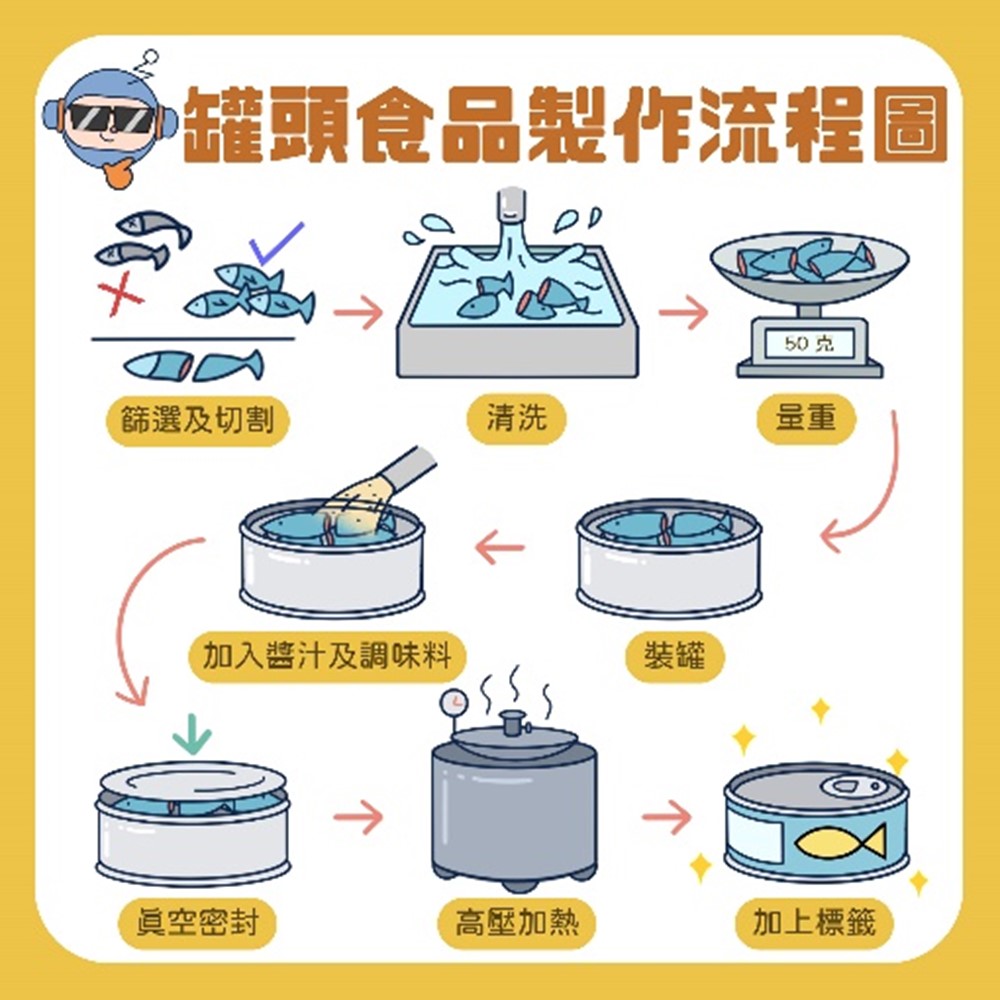
- Check canned foods for signs of damage. Do not buy canned foods with a severely dented, visibly bulging, rusted or damaged can, and even more so, do not eat the food inside.
- Check the expiry date of canned foods, and store them according to the manufacturer’s recommendations.
- Make healthier choices by reading the nutrition labels to avoid excessive intake of sodium (salt), sugar or fats.
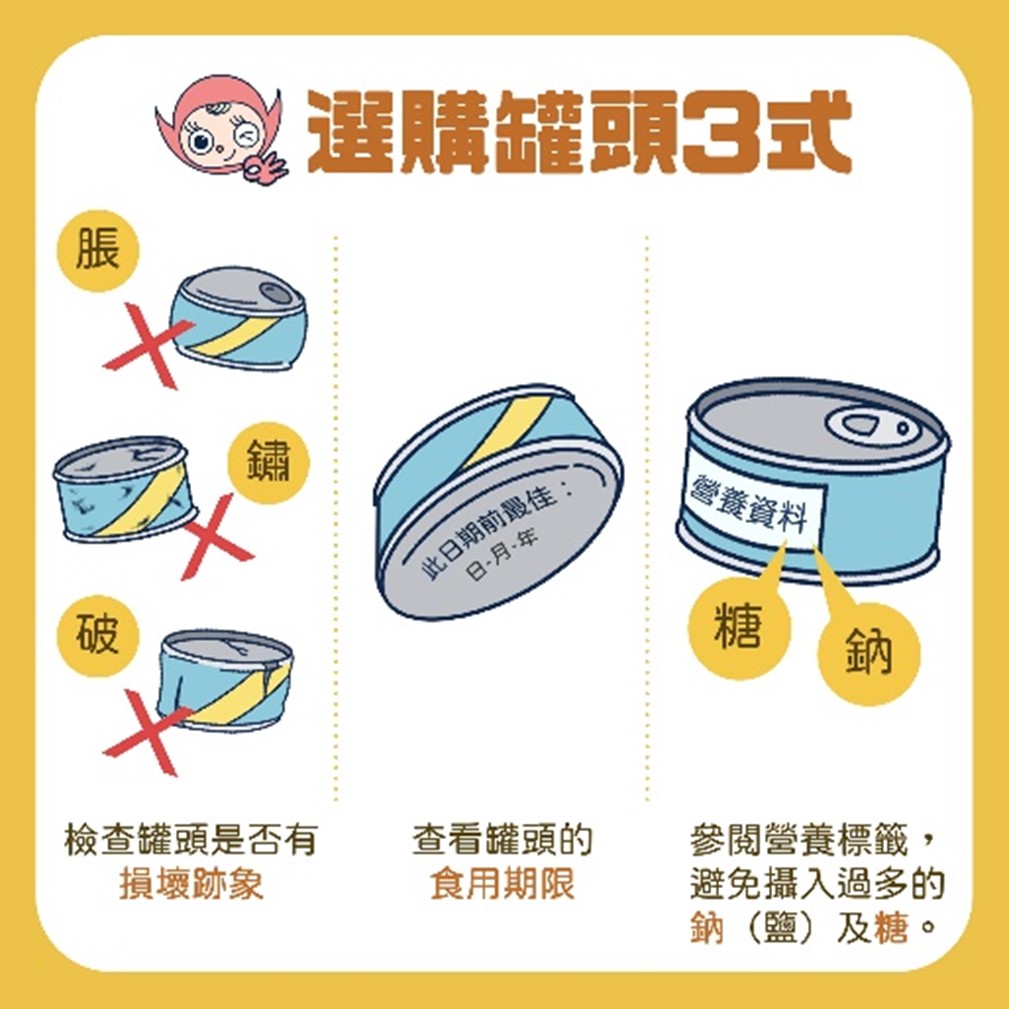
To learn more about canned foods, please visit the following webpage or scan the QR code: https://www.cfs.gov.hk/english/multimedia/multimedia_pub/multimedia_pub_fsf_186_02.html

Dining Out
How to Choose Congee Wisely to Avoid High Sodium Intake
The CFS released the study results on the sodium content in Chinese congee in December 2023. Although none of the samples were considered “high” in sodium (i.e. over 600mg/100g), the sodium intake from consuming one bowl of certain types of congee, such as congee with pig’s liver, may already reach the World Health Organization (WHO)’s recommended daily intake upper limit due to the considerable volume consumed. In this article, we will explore how to reduce sodium intake and healthier ways to eat this traditional Chinese favourite.
WHO Guidelines on Reducing Sodium Intake
Excessive sodium intake is closely related to hypertension, which is a risk factor for non-communicable diseases including cardiovascular diseases and stroke. WHO recommends a daily salt intake of less than 5g (i.e. around 2 000mg of sodium) for adults. In Hong Kong, according to the Population Health Survey 2020-22 conducted by the Department of Health, persons aged 15-84 consumed 8.5g of salt (i.e. around 3 400mg sodium) per day, which exceeded WHO’s recommendation of salt intake per day for adults. Therefore, it is important to reduce dietary sodium intake for Hong Kong people.
Risk Assessment Study on Sodium Content in Chinese Congee
The Study
174 samples, including 12 types of Chinese congee with ingredients, as well as the plain congee base and seasoned congee base available as the choice of congee base for cooking, were collected from local Chinese restaurants, fast food restaurants and congee shops for analysis of their sodium content. The study results are shown in the table below. The sodium content of all samples of congee with ingredients ranged from 33mg/100g to 460mg/100g, with an average of 270mg/100g. The wide variations in the sodium content observed within the same type of congee samples suggested the potential for sodium reduction in these congees by the trade. The sodium content of a plain congee base was substantially lower than that of a seasoned congee base, indicating that the sodium intake from the consumption of congee can be lowered to a great extent by choosing plain congee instead of seasoned congee as the base for making congee with ingredients.
Congee Types with the Highest Sodium Content
Congee with pig’s liver, congee with chicken, congee with pig giblets and congee with preserved egg and pork had the highest average sodium content. This is probably due to the naturally higher sodium content in liver and other internal organ meats, and the higher amounts of seasonings typically used to marinate chicken, pork and other meat ingredients.
Congee Types with the Lowest Sodium Content
Congee with pumpkin, congee with fish and congee with sweet corn had the lowest average sodium content because vegetable ingredients and fish are usually not seasoned/marinated before cooking, while ginger and spices are often added instead to fish fillets used to make congee.
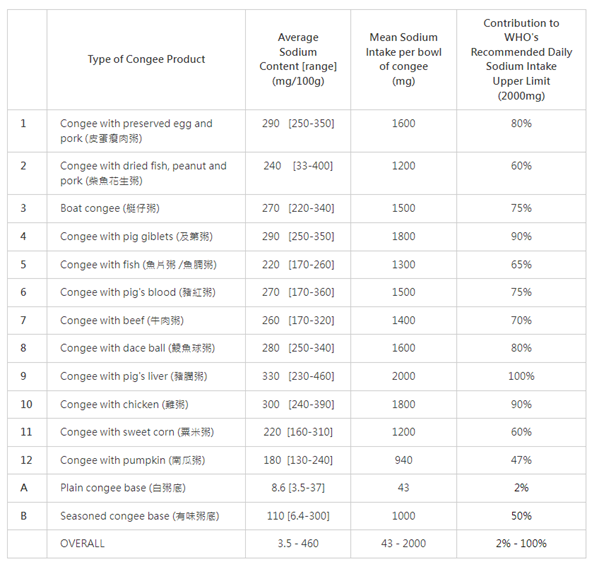
Sodium content and sodium intake per bowl of congee (contribution to WHO’s recommended daily sodium intake upper limit)
Healthier Ways to Eat Congee to Take in Less Sodium
There are healthier ways to enjoy congee to avoid excessive sodium intake: choosing ingredients with lower sodium content such as fish and vegetables, choosing less internal organs and meat with high sodium content, sharing the congee when the portion is large and requesting plain congee instead of seasoned congee as the base, which can significantly lower the sodium intake from congee. The trade should strive to use less salt and seasonings in preparing congee bases and ingredients, offer the choice of smaller portions of congee to consumers, and provide plain congee with little or no salt added as an alternative to the regular seasoned congee base. Furthermore, using less salt or seasonings when preparing congee at home is a great way to control and reduce the amount of sodium intake.
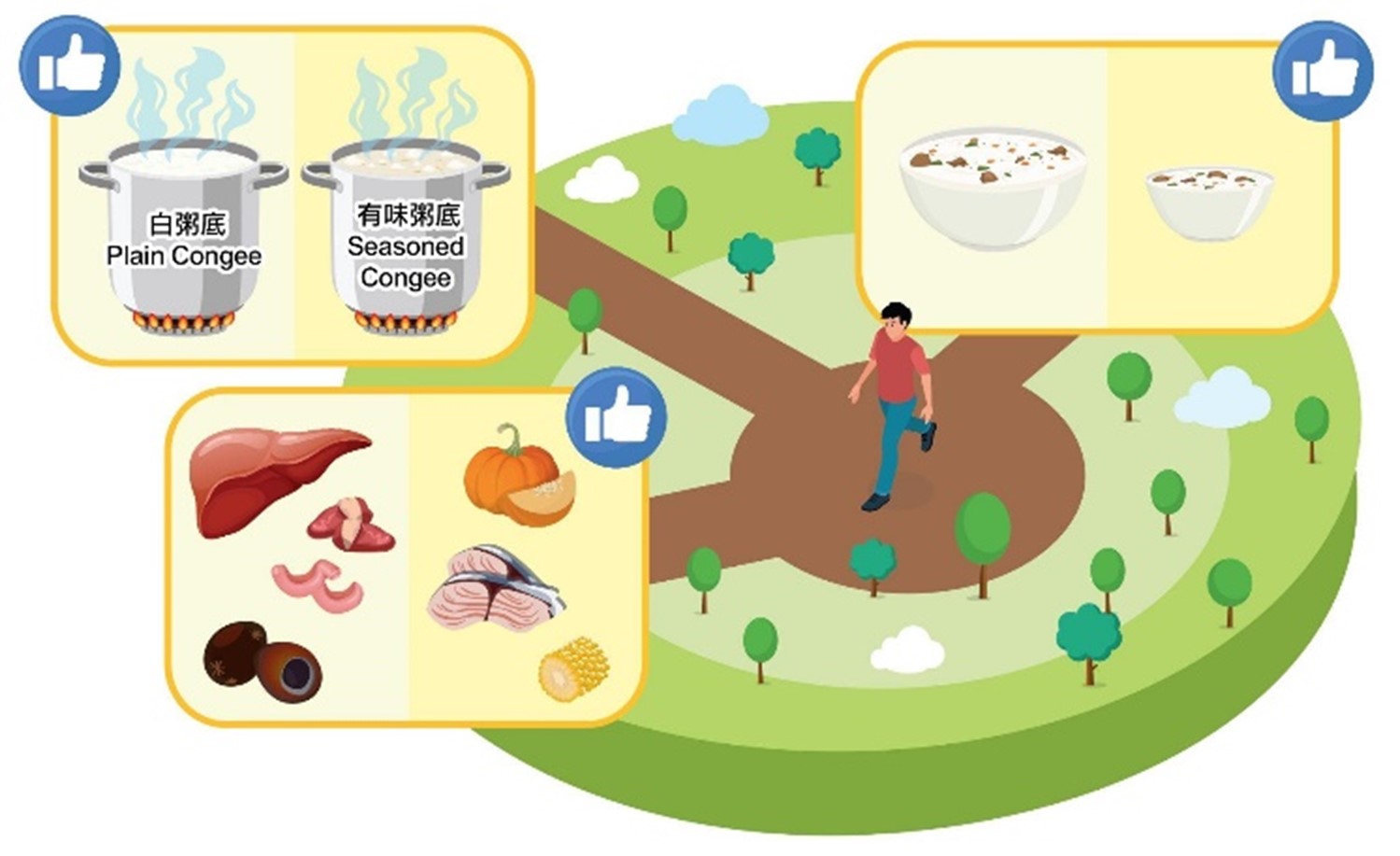
Make healthy choices to reduce the amount of sodium intake from congee: choose ingredients with lower sodium content such as fish and vegetables, choose plain congee with little or no seasonings added as the base, and consume congee in smaller portions
Advice to Consumers
- l Pay attention to the sodium content in Chinese congee and choose carefully.
- Order congee cooked with a plain congee base instead of a seasoned congee base.
- Pay attention to the amount of congee consumed. Consider sharing the congee when the portion is large.
- Maintain a balanced diet with variety.
Healthy Eating Basics and Smart Food Choices
Healthy Eating Basics
Understanding Ultra-processed Foods and the Related Healthy Eating Approaches
The subject of ultra-processed foods is a hot topic among nutritionists and health professionals. In this article, we will briefly go into the history of this term, how the Food and Agriculture Organization of the United Nations (FAO) used this term in their publications and how the public should adopt a healthy diet in light of the given information.
How this Term Arose and How it is Cited in FAO Publications
The term “ultra-processed foods” first came from a paper written by researchers at the University of Sao Paulo in Brazil in 2009. They put forth the NOVA system, a food classifying system that groups foods according to the degree of processing, aiming to improve the understanding of food processing and its effects on health, as nutrients of foods are thought to be inadequate in capturing the health impact of food processing. Currently, foods are categorised into four groups in FAO publications.
- Group 1: Unprocessed or minimally processed foods - these foods are in their natural state or have undergone minimal processing such as drying, freezing and vacuum packaging. Examples include fresh fruit, frozen vegetables and powdered milk.
- Group 2: Processed culinary ingredients - these foods are ingredients used for cooking at home or in restaurant kitchens and are produced through processes such as pressing, refining and milling. Examples include vegetable oils, sugar and salt.
- Group 3: Processed foods - these food items are made by combining Group 1 with Group 2. Examples include canned vegetables in brine, tinned fish preserved in oil and salted or sugared nuts and seeds.
- Group 4: Ultra-processed foods - these products are typically made through industrial manufacturing processes. Sugar, oils and fats and salt are commonly used in ultra-processed foods and are often combined as ingredients. In addition, ingredients characteristic of ultra-processed foods are either food substances that are rarely used in culinary practices or additives of various classes (such as flavour enhancers, colourings and artificial sweeteners). Examples include carbonated soft drinks, potato chips, cookies, instant noodles and frozen pizzas.
How do some Health-related Authorities and Organisations View it?
FAO publications reviewed studies on ultra-processed foods, and pointed out the association between their nutritional quality (including high levels of free or added sugar, saturated and trans fats, sodium and energy density, and low protein, fibre and potassium contents) and non-communicable diseases. Some international organisations, such as the National Institutes of Health of the United States, Pan American Health Organization of WHO and the Lancet, emphasise the negative impact of ultra-processed foods on health and some even link them as a cause of obesity. They recommend reducing or eliminating these foods from the diet in favour of unprocessed, nutrient-packed options.
Furthermore, a recent large-scale study that was published in the British Medical Journal in February 2024 found that consuming a larger amount of ultra-processed foods increases the risk of a range of health problems such as cardiovascular disease, diabetes, obesity, anxiety, and that of mortality. However, the researchers acknowledged that the study had its limitations. For example, confounder adjustments such as those for unhealthy dietary patterns had not been considered. Additionally, more studies are required to facilitate understanding of how ultra-processed foods affect health.
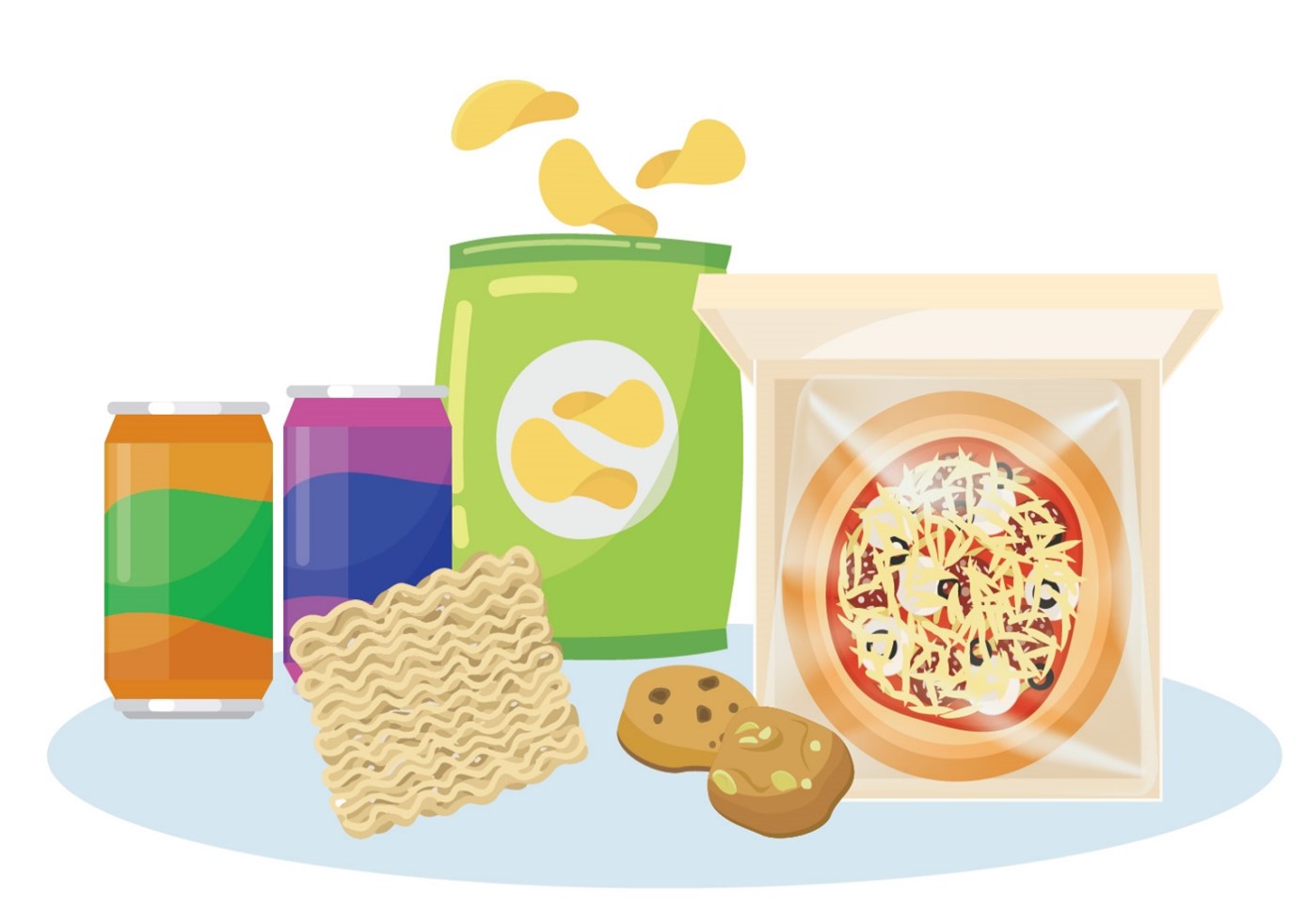
Common examples of ultra-processed foods, such as carbonated soft drinks, potato chips, cookies, instant noodles and frozen pizzas
How the Public Should Approach Such Food Classification
Rather than trying to completely abstain from the consumption of ultra-processed foods, one should eat a healthy and balanced diet, which entails consuming a variety of food in the appropriate amounts as recommended by the Healthy Eating Food Pyramid. When adopting a healthy and balanced diet, it is more important to consider the nutritional quality of foods than the level of processing alone. In fact, one of the existing key messages promoted by the Department of Health in healthy eating principles is to reduce the intake of foods with high fat/oil, salt and sugar contents as well as preserved and processed foods. Here are some easy and healthy eating tips demonstrating how to practise this principle:
- Replace carbonated soft drinks with water, water infused with a slice of fresh fruit (such as lemon, orange) or tea.
- Snack on unsalted and non-fried nuts or seeds and fruit (such as fresh apple slices, dried and unsweetened apricots) instead of potato chips and cookies.
- Prepare healthy meals at home. For example, instead of having instant noodles with luncheon meat or sausages, cook non-fried noodles in soup with fresh or frozen vegetables and fresh meat or fish slices.
Notwithstanding the difficulty in classifying foods according to the NOVA system due to the ambiguous nature of classification, limiting the intake of fatty, salty, or sugary products in this food class can still be achieved by reading nutrition labels. Therefore, do make it a habit to use nutrition labels for choosing appropriate prepackaged foods which are, for example, lower in sugar and salt contents. For individuals who need personalised health advice, please consult a dietitian or healthcare professional.
Healthy Eating Basics and Smart Food Choices
Smart Food Choices
Beef Tenderloin Dices with Pears
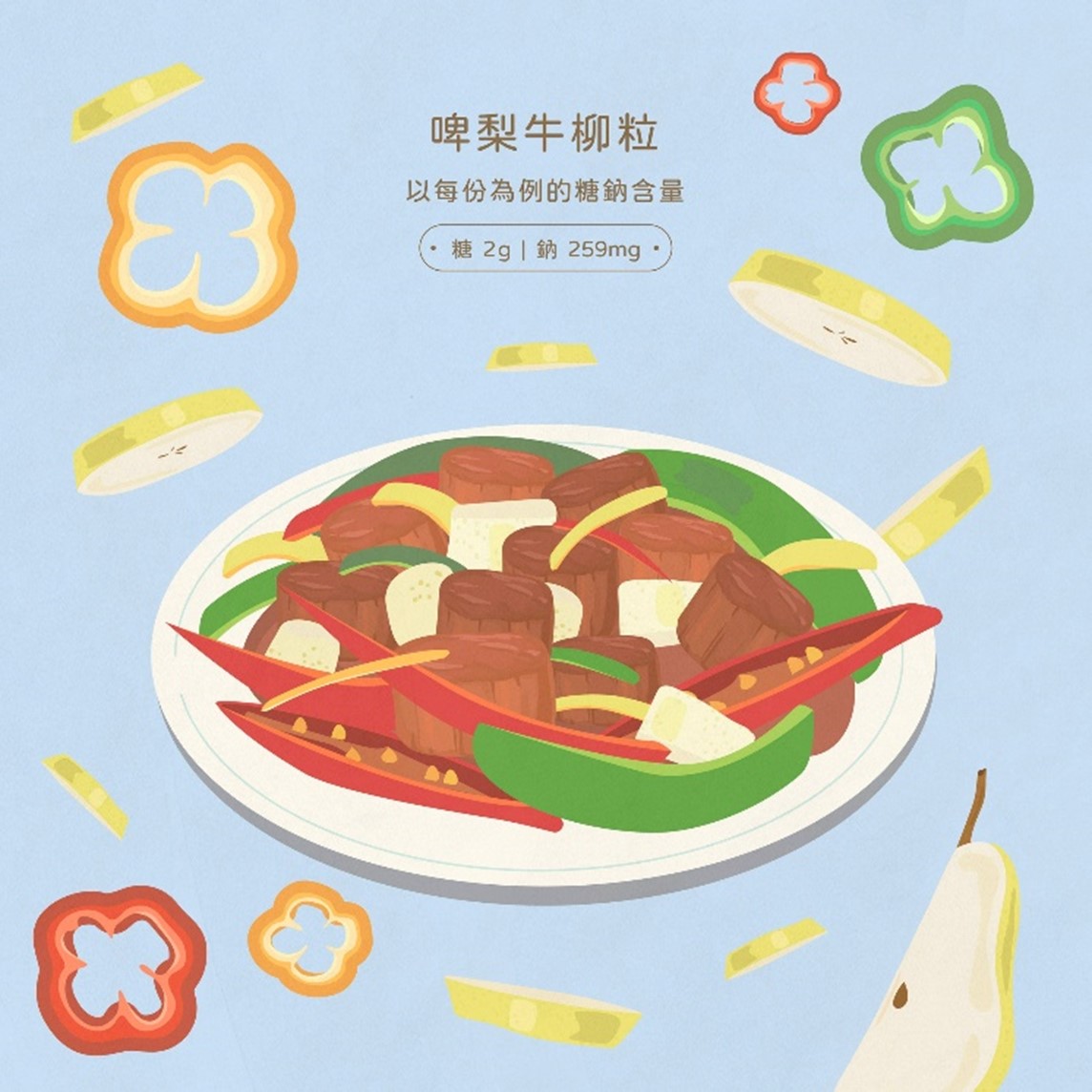
For a splendid beef dish, it is preferably to keep the seasonings and ingredients simple to highlight the flavor of the beef itself. This recipe for beef tenderloin dices uses only four ingredients, including pears, which, in addition to being rich in dietary fibre, has a natural sweetness that can be used for seasoning, allowing you to add less sugar! Check out this “EatSmart Recipe” now:
https://restaurant.eatsmart.gov.hk/eng/content.aspx?content_id=1259
-
CFS’s Online Seminar on Handling of Ready-to-eat Food

The CFS is committed to ensuring food safety. To raise the awareness of food safety among staff of food factory producing ready-to-eat food, the CFS held an online seminar on 5 September to remind food workers to follow Good Hygiene Practices (GHPs) and maintain good personal and environmental hygiene at all times.
For more information on ready-to-eat food, please scan the QR code.

-
FEHD strives to enhance food safety of catering services for tour groups

The Food and Environmental Hygiene Department (FEHD) has launched a special round of operations to inspect food premises serving tour groups in various districts of Hong Kong with reference to the list provided by Travel Industry Authority, with the aim of enhancing food safety and hygiene awareness among the caterers.
The inspections, being carried out jointly by the Centre for Food Safety (CFS) and Environmental Hygiene Branch since September 12, 2024 are to ensure that the licensing conditions regarding food handling and processing are observed by the operators, and that the hygienic standards stipulated in the laws are met. During the inspections, FEHD staff also provide food safety and hygiene education to operators and their employers, and collect food samples for testing."
Furthermore, the CFS collaborated with the Travel Industry Authority to host an online health talk for tour group catering service providers on September 13, 2024 to provide advice on safe food preparation and remind them to maintain good personal, food, and environmental hygiene at all times. Caterers were also encouraged to adhere to Good Hygiene Practices and develop a food safety plan based on the Hazard Analysis and Critical Control Point system.
The FEHD will continue to monitor the situation and maintain close liaison with relevant stakeholders to safeguard public health and ensure that food safety standards are upheld.
For more information on the relevant “Food Safety Focus”, please scan the QR code.

-
The 86th Meeting of the Trade Consultation Forum
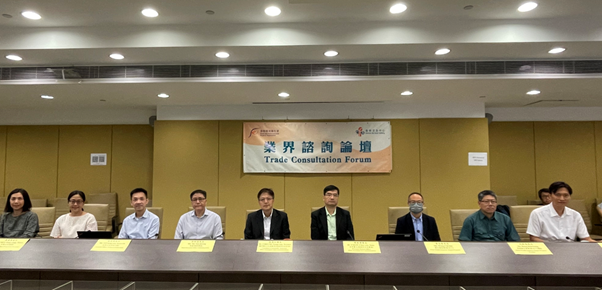
The 86th meeting of the Trade Consultation Forum was held on 20 September. The CFS and the trade exchanged their views on various topics including “Food safety guide for food recovery programmes”, “Food labelling and nutrition labelling of prepackaged food”, “Utilisation of Hong Kong-Zhuhai-Macao Bridge for import of fresh produce”, “Advance release arrangement for Hong Kong-Manufactured food products entering the Mainland Market”, and “Revised fee for application for Recommendation on Food Manufacturer Registration (applicable to export of the specified 18 categories of food products to the Mainland)”. For details of the event, please visit:
https://www.cfs.gov.hk/english/committee/Notes_and_Presentation_Materials_TCF86_20240920.html

Ask Mascot On
Food Safety Hazards of Raw Oysters
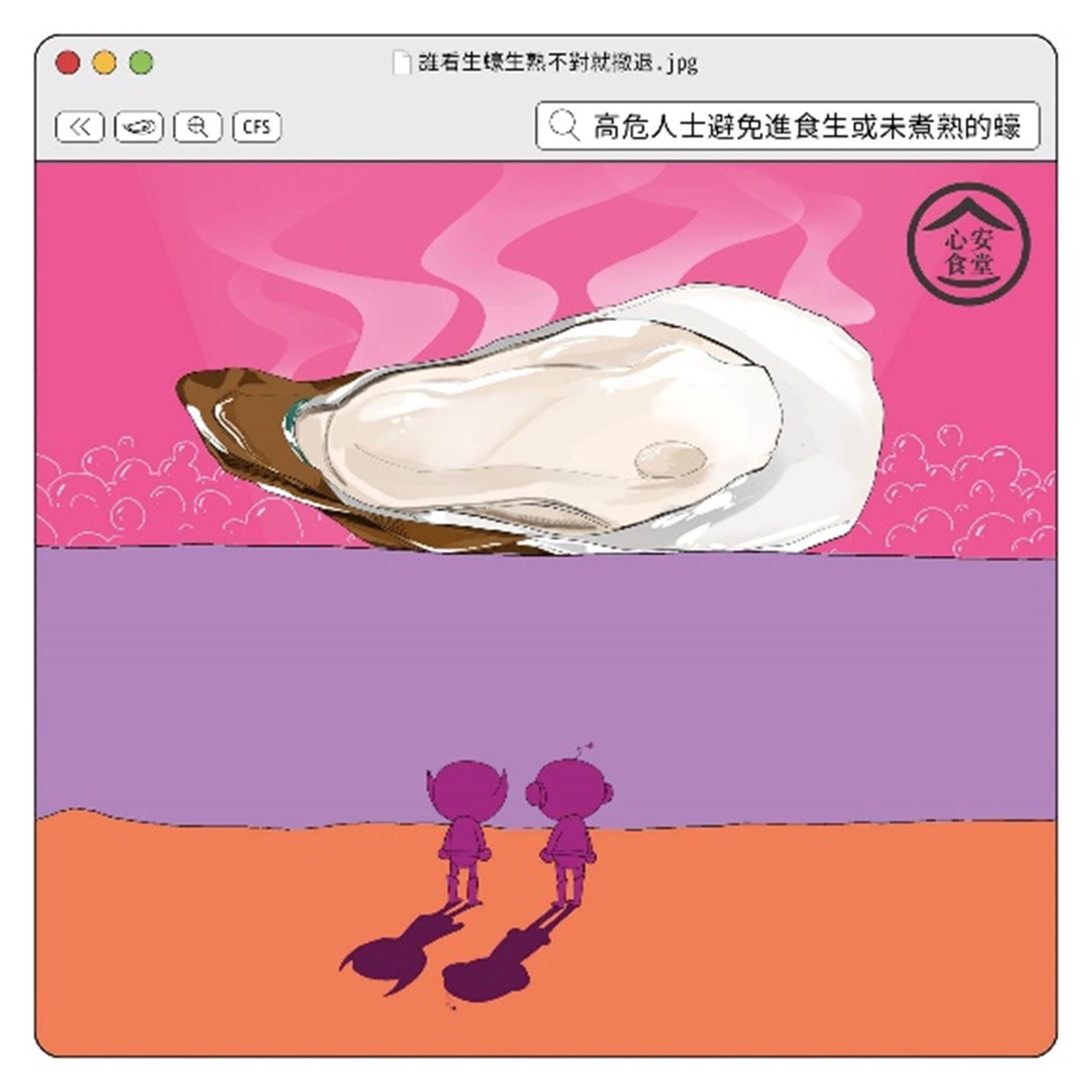
Raw oysters available on the market can be generally categorised into whole-shell, half-shell and pre-shucked raw oysters (such as those packed in tubs or boxes). Feeding by filtering seawater, oysters are susceptible to contamination if the waters in which they grow carry pathogens such as norovirus.
It is worth noting that pre-shucked raw oysters carry a higher microbiological risk than oysters with shell do because pre-shucked raw oysters are more prone to be cross-contaminated during the handling processes, which involve various manual and machinery work. In addition, oysters die after shucking, and their flesh is therefore more perishable. Without proper temperature control during transportation or storage, the oyster flesh may deteriorate quickly, resulting in the multiplication of bacteria and hence a higher food poisoning risk to consumers.
Raw oysters, served without cooking to destroy pathogens and viruses, carry some inherent microbiological risks. Susceptible populations, including pregnant women, young children, the elderly and the immunocompromised, should refrain from consuming raw or undercooked oysters.
The most effective way to destroy pathogens that may be present in oysters is to cook them thoroughly, i.e. heating them to a core temperature of 90℃ for 90 seconds. If you really want to eat raw oysters, make sure to patronize reliable licensed shops or restaurants only. The sale of seafood, such as raw oysters, for raw consumption requires written permission/endorsement from the Director of Food and Environmental Hygiene.
Food Safety Quiz
- Which one of the following may contain grayanotoxins?
- Raw oyster
- Honey
- Taro
- Sashimi
- What is the microbiological risk of pre-shucked raw oysters (such as oysters packed in tubs or boxes) as compared to oysters with shell?
- Lower
- The same
- Higher
- Cannot be compared
- Which one of the following congee has the highest sodium content?
- Congee with pumpkin
- Congee with fish
- Congee with pig’s liver
- Congee with sweet corn
Diary of Mascot ON
Food Poisoning from Consumption of Wild Taro
In January 2024, a 50-year-old woman developed a sore throat and hoarseness after consuming wild taro she collected from a hillside. She was admitted to hospital for suspected calcium oxalate raphide poisoning and was in stable condition.
Many types of plants contain oxalates. Some, like sodium and potassium oxalate, are soluble in water. Others, like calcium and magnesium oxalate, can form insoluble crystals. The raphides (needle-shaped crystals) are of particular concern as they cannot be destroyed by cooking and can shoot out from the plant cells in all directions after being chewed. This can lead to irritation and injuries to the oral cavity.
Locally, food poisoning cases associated with calcium oxalate raphides mainly involve the consumption of wild taro or other produce that are suspected to be mixed or wrapped with wild taro leaves. To prevent calcium oxalate poisoning, do not pick and eat wild plants and do not use wild taro leaves to cover or wrap produce during transportation and processing.
